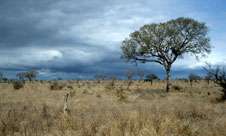Tree domination of the world's savannas may slow down

Savannas are becoming increasingly woodier as trees gain the upper hand over grasses in these ecosystems, but this encroachment may proceed more slowly than previously thought, new University of Otago-led research suggests.
Lead researcher Professor Steven Higgins of the Department of Botany says several lines of evidence suggest that many savanna ecosystems around the world are becoming increasingly dominated by trees.
"It is thought that the advance of trees in these eco-systems is fuelled by increases in atmospheric carbon dioxide. Due to their different lifestyles and photosynthesis systems, trees are better positioned to take advantage of higher CO2 levels than grasses are."
Alongside CO2, another key factor controlling the growth of plants is the rate at which nitrogen is made available to them in soils.
Professor Higgins and his team undertook a field experiment in Kruger National Park, South Africa, to test whether nitrogen cycling in savannas would change as trees come to dominate.
Their findings suggest that nitrogen cycling will significantly slow as trees advance and that this may in turn limit the rate at which trees encroach into savannas.
The study appears in the UK Royal Society journal Biology Letters.
In earlier research published in Nature, Professor Higgins and colleagues in Germany had produced a model indicating that large swathes of Africa's savannas may well be forests by 2100.
"This new study is fairly bold and speculative, but that is how science progresses. I think it is a fun and provocative idea, supported by a neat, well-designed experiment, but we will have to see if our experimental system is a special case or indeed representative of what might happen in a suite of savannas."
"Our latest research illustrates that puzzling out just what limits plant growth is far from trivial—if it is not atmospheric carbon dioxide, then perhaps it is nitrogen, or phosphorous?"
Professor Higgins says this very conundrum has challenged plant scientists for a good part of the almost two centuries since Justus von Liebig, the father of the industrial fertiliser industry, first drew attention to the issue.
"It's a challenge we have to master for a wide range of reasons, from using fertilisers more efficiently, to anticipating the impacts of global change," he says.
More information: "Feedback of trees on nitrogen mineralization to restrict the advance of trees in C4 savannahs." DOI: 10.1098/rsbl.2015.0572
Journal information: Biology Letters , Nature
Provided by University of Otago




















